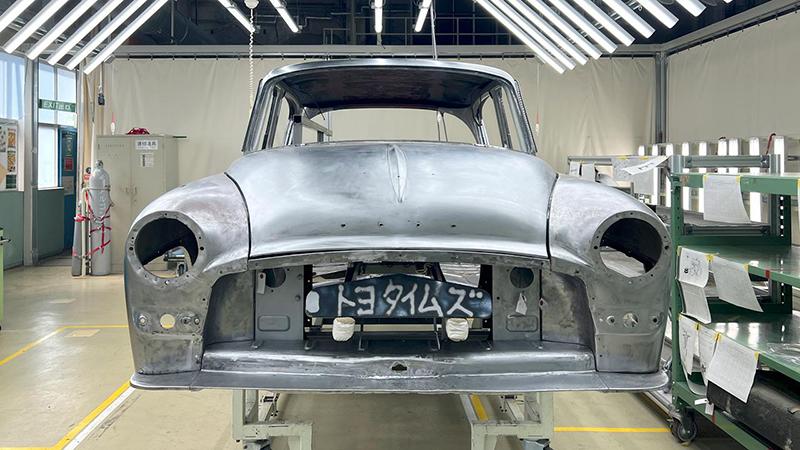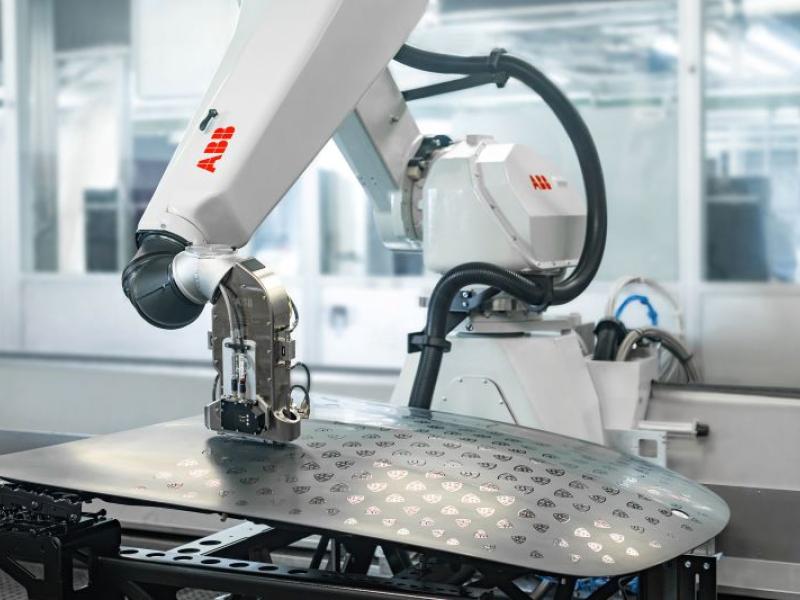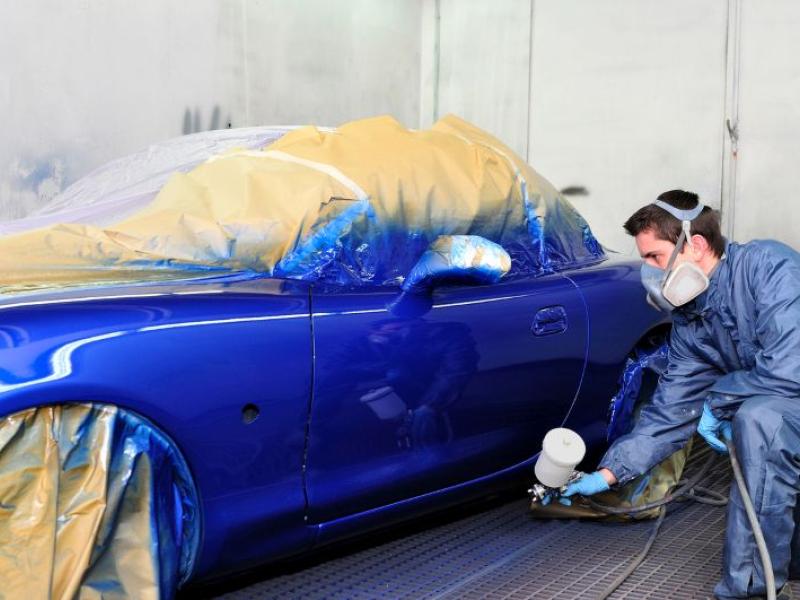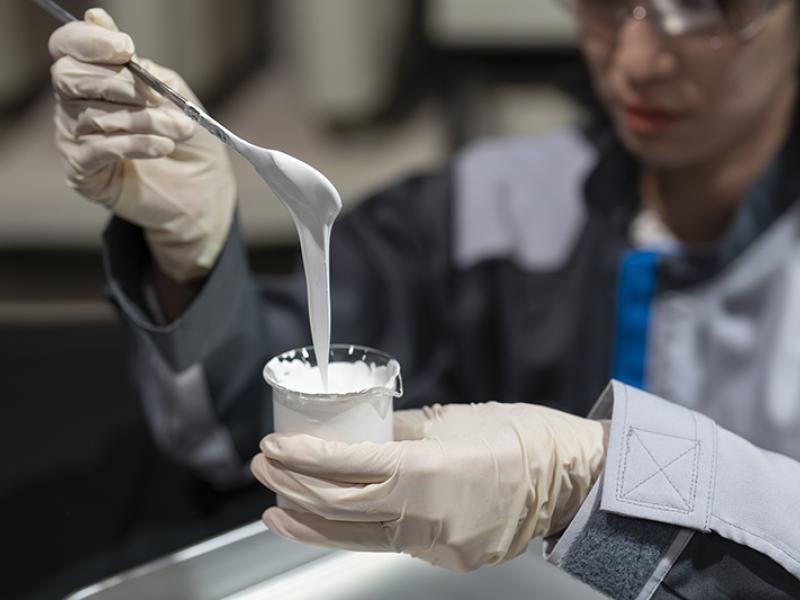A project to restore the first-generation Crown started in the spring of 2022 at the Motomachi Plant, bringing together a diverse group of skilled members.
In a corner of the Motomachi Plant being used for painting work, the body of the disassembled first-generation Crown finally stood ready for restoration to begin. Led by final line assistant manager Minato Ishibashi, the team entrusted with this task brought together nine experts from across the company, including production genba staff from the Tahara, Takaoka, Tsutsumi, and Motomachi Plants, and welding specialists who can normally be found building prototypes at the Technical Development & Prototype Div.
Team leader Ishibashi recalls the condition of the body at that time.
The chassis was very solid, and with the paint on the body, it also seemed to be in good condition.
The way things looked initially, we felt we could wrap up the body restoration work within a month. However, when we removed the interior and core components, we realised it would not be so simple.
Team members began by using paint remover to completely strip the paint from the body, returning the body panels back to silver-coloured steel sheets. In doing so, they uncovered countless sections of bright red rust and minor dents that had lain concealed under the paint.
More than six decades of rust and dents had taken a severe toll. In particular, the corrosion on the underbody, which is not visible from outside, and areas where rainwater inevitably pools, such as the bottom of doors and wheelhouses, turned out far worse than expected.
Remaking body panels from moulds
These circumstances turned the body restoration into a far more colossal and difficult task than even the team of crack technicians had imagined. Another reason was the fact that, as befitting a car manufacturer, they were aiming for a flawless restoration that would surpass the quality of the original down to the innermost details.
Right from the initial rust removal, the work was extremely arduous. It involved meticulously removing the rust by hand using a file and paste. Any speck of rust left on the surface would show up when the body was painted, creating an uneven area that would ruin the beautiful finish and allow corrosion to set in again.
One of the team members, SX Takaaki Sato from the Lexus Body Section at the Tahara, describes the challenge:
“Unlike today’s cars, in the first-generation Crown, the joints between parts were not sealed. This means that, given the car’s age, rusting was inevitable.
And yet, seeing the extent of corrosion brought home just how terrible rust is. We also found makeshift repairs where dents in the body had been patched up with putty, which couldn’t be left as they were.”
After several weeks of removing rust by hand, the team was finally ready to move on to panel beating. This step entailed using hammers and other tools to manually knock out any dents and return the metal to its original form.
In sections that had been patched up with putty, the putty must first be removed before the panels are beaten. Smaller dents are repaired one by one using a method called “stud welding,” in which a copper stud is temporarily welded to the surface of the dented metal, where it can then be pulled on to draw out the dent.
Unfortunately, not much can be done about areas where a steel sheet has been thinned by rust removal or corroded to the point of having holes. The first-generation Crown’s body was assembled by welding together many panels made of steel sheets.
Where the damage is minimal, the area can be repaired by welding on another steel sheet. If a panel is severely damaged, however, the only option is to remake the entire piece from scratch with sheet metal working. This means making a mould of the panel, which is then used to hammer the steel sheet into the desired shape.
Heavily damaged panels are removed from the body, and newly fabricated panels are welded in their place.
Despite the constant challenges, the body team’s nine experts pressed on tirelessly with the panel beating, welding, and panel fabrication. As it happens, Ishibashi is a master welder who has guided plant start-ups in Japan and around the world.
I’ve been involved in production site work for many years, but this restoration project was full of new experiences. For instance, in my whole career, I had never made body panels from moulds. We were able to complete the task through the joint effort of our skilled technicians.
As the work progressed, we found more areas that we wanted to improve. Time and again, I ended up asking our members’ various departments to let them stay on longer.
The basic tasks were the same as my regular work, yet somehow, we struggled. Even at its thinnest, the first-generation Crown’s body measures at least 1mm, much thicker than today’s cars. Trying to hammer the body back into its original shape doesn’t work out as you imagine. Every step is a challenge. You just have to get in there and try.
The more difficult the work, the more determined the team became. Going through the process also gave them a greater appreciation for the incredible skill of the people who had built the car 65 years earlier.
With its rounded fenders and countless curves, the body of the first-generation Crown is a testament to the craftsmanship of its creators.
Take for example the exquisitely rounded fender, which forms one of the highlights of the streamlined body. This section is composed of three panels welded together. To pull off such advanced welding without the equipment we have today, the craftsmen of the day must have been incredibly skilled.
Alongside conventional sheet metal welding techniques, Toyota used “incremental forming,” a method rarely seen on car body mass-production lines, to fabricate the Crown’s panels. The restoration team’s efforts to introduce such new methods will be featured in future articles in this series.
After several months that presented an “all-round challenge” even for Toyota’s skilled veterans, the body restoration work was completed at the end of October 2022. With that, the team moved on to the next step: painting.
65-year-old car meets modern electrodeposition coating
Within the painting process, the team undertook a groundbreaking experiment that will play an important role in efforts to make existing cars carbon-neutral: the introduction of cationic electrodeposition coating for the body and chassis.
Cationic electrodeposition coating is a basecoat technique used on all current vehicles, not just Toyota cars. The technology involves submerging metal parts in a tank of dissolved water-soluble paint, then applying a direct current with the submerged part acting as the negative pole and the paint solution as the positive. Paint on the metal’s surface is transformed into an insoluble polymer, coating the part without the slightest gap.
This technique makes it possible to coat every nook and cranny, even in areas that are unreachable when painting by hand, such as rocker panels and the inside of chassis frames. What’s more, because the metal surface is completely covered at the molecular level, the risk of rusting can be eliminated so long as the coating is not damaged. However, applying the coating requires a paint-filled pool large enough for the entire body to be submerged.
Ideally, the team could make use of the production line for a current model, but the process is fully automated and not set up to handle odd jobs. And since the 65-year-old body was not designed with electrodeposition coating in mind, there was no guarantee that the attempt would not cause paint quality issues for the entire line of cars that came after.
As an added hurdle, a purpose-built jig would be needed to take the first-generation Crown down a production line for current models, costing upwards of ten million yen. For these reasons, no coating line could be found to perform the process in-house.
Regardless, the team was undeterred. They believed cationic electrodeposition coating for the body and chassis was absolutely essential to keep the Crown running in top shape for another 50 or 100 years, and to fulfil the wishes of car lovers eager to keep their beloved rides on the road.
Toyota Housing helps make cationic electrodeposition coating a reality
The team members scoured every corner of Toyota, looking for someone who was doing cationic electrodeposition coating. Finally, they came upon a group company eager to take up the challenge: Toyota Housing, which develops and builds homes, offices, and commercial facilities.
Toyota Housing started out in 1975 as the Housing Division of Toyota Motor Co. before being established as a Toyota Group company in 2003. The steel rigid frame units that serve as the company’s housing frames were originally born out of car-making technology. As it happens, these frames are also treated with cationic electrodeposition coating.
The Crown body team arranged to use the cationic electrodeposition coating facilities set up for Toyota Housing’s steel rigid frame units.
Even at Toyota Housing, the team faced two hurdles in pursuing cationic electrodeposition coating. First, the existing pallet and mounts would not allow the Crown’s body to be fully immersed in the paint, leaving some areas uncoated. The second obstacle was removing rust from internal sections of the body and chassis that could not be reached by hand.
Based on their previous discussions, the members cleared the first hurdle by building their own pallets and mounts to ensure sufficient immersion depth. The second problem was also solved by enlisting the help of Teikuro, surface treatment and coating specialists who chemically remove rust from large moulds. Teikuro assisted the team with thorough rust removal and degreasing of metal surfaces to improve coating quality.
Thanks to these efforts, the team finally achieved the unprecedented step of applying cationic electrodeposition coating to the body and chassis of an old car as part of the restoration.
Toyota’s highly skilled technicians managed a flawless body restoration that surpassed the original, complete with cationic electrodeposition coating thanks to the generous assistance of Toyota Housing. In doing so, they achieved more than the restoration’s aims of passing on skills and developing talent; the experience and results gained in the process will no doubt extend beyond the first-generation Crown restoration project.
As this project has shown, restoring old cars is full of difficulties and amusing anecdotes that are not found in new car production. Part 5 of this series will focus on these hurdles and fascinating stories from the first-generation Crown restoration.






